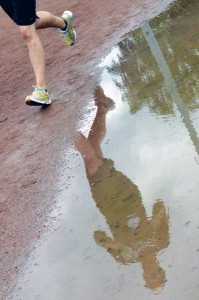
Shin splints are a common injury for both beginner and avid runners.However, those who play soccer, do aerobics or like to take a stroll in the park are just as likely to sustain this same type of injury. In this article I will address some of the common causes of shin pain, as well as provide some techniques for preventing shin splints.

The Pain that You Can’t Stretch Away – Shin Splint Symptoms
Shin splints may be used to describe the symptoms of a lot of other lower leg problems, but it generally refers to a condition called Medial Tibial Stress Syndrome (MTSS).
Shin splints are caused by an inflammation of the tendons near the tibia, one of the long shin bones.Another possible cause is a pulling of the periosteum, which is a thin coating on bones, while running or doing aggressive walking.
The pain tends be centrally located on the front part of the lower leg, right below the knee.Shin splints usually start out as a dull pain with some discomfort at the beginning of the workout and reappear towards the end of the workout. One of the distinctive telltale signs of this injury are lumps and bumps along the tibia caused by inflammation.
How Come Stretching Before My Run Isn’t Helping? Shin Splints Streches
For those who are runners, shin splints tend to come on when distance is increased rapidly or during an intense workout.The increased strain on the muscles leads to intensified inflammation.Leaving it alone or cutting back on your workouts may lessen or cause the inflammation to go away, but when the workouts resume, it will come back with a vengeance.Some other causes include rolling the ankle while running or walking, tight calf muscles, a tight Achilles tendon or weak ankle muscles.
What Can I do to Correct or Prevent Shin Splints?
1. If you are experiencing either overpronation (excessive inward rolling of the ankle) or oversupination (excessive outward rolling of the ankle), find running shoes which are suitable for treating the imbalance. Seeking out a good podiatrist or footwear salesman who can take a look at your gait and provide good recommendations is highly recommended. This may help you prevent shin splints.
2. If you are experiencing shin splints as you increase your mileage, then following this rule:distances should not increase by more than 10% per week. The running surface may also be to blame as well for your shin splints; avoid running on concrete and opt for either tarmac, grass or sand where there is more shock absorption for your legs.
3. The best method for shin splint self treatment is to use the RICE method: Rest, Ice, Compression and Elevation.This should be done within the first 48 to 72 hours from sustaining the injury to ensure the best chance for a full recovery.
4. Taking the time to warm up and stretch prior to your workout or run is essential to prevent any tears or injuries that can occur when exercising on stiff and cold muscles and tendons. For pain relief from shin splints, yoga therapy exercises like the Post Athletic Stretch DVD can help stretch the calf muscle and Achilles tendon.
Shin splints may cause a setback on your running or workout progress, but taking the steps to look at the causes and preventing the problem will be beneficial in the long run.
Discover our solutions for foot and ankle pain relief.
Watch our free 5 minute feet and ankle video.
Check out our Post athletic stretch DVD












Hi Tia,
Thanks for your post. I teach dance and have come across students who struggle with shin splints. I will use your suggestions to help address the issue.
I use to get shin splints after sprinting at my gym. Also I had asked a couple of trainers if they knew away to get rid of shin splints and none of them knew. Thanks to your article I now know what to roll with my Yoga Tune Up balls, when I get shin or knee splints from doing improper squats . Thanks for sharing
nice article Thanks!
Thank you for sharing these practical steps for correcting and/or preventing shin splints. I have many students and friends who run the Honolulu Marathon that will benefit from this blog post. Living in hawaii there is plenty of grass and sand for people to opt to train on, now its just getting them in the mindset to do so.
I wish I had this information when I was an athlete in school! So many times we either played through the pain, and wondered why our shins hurt. I will definitely be checking out that DVD for the sport specific stretches.
Thank you for a very legible explanation of shin splints, and noting that the site of the pain is not always where the solution lies. Such a critical distinction!
Thanks so much for this info. I really like the 10% rule…good for the marathoners! I hope you continue to share more Yoga Tune Up best practices for runners!
this is good advice. i quit running altogether b/c of shin pain. maybe i’ll start running again.
I have been a runner my whole life, so my interest was peaked when I saw the title of this blog post. What great information to keep in mind as I practice my yoga as well.
This is great information. As a former runner, I used to suffer from shin splints (I can still feel the lumps and bumps down my tibia). I have found that my pain has been completely resolved through stretching my calf muscles and achilles tendon in yoga. Thanks!
Thank you for explaining this condition in easy to understand language.
I had the wrong idea of shin splints altogether! didn’t know they were a result of inflammation of a tendon. I’m interested in purchasing the Post Athletic Stretch DVD so I can help relieve the pain of my yoga students who are also athletes.
great info!